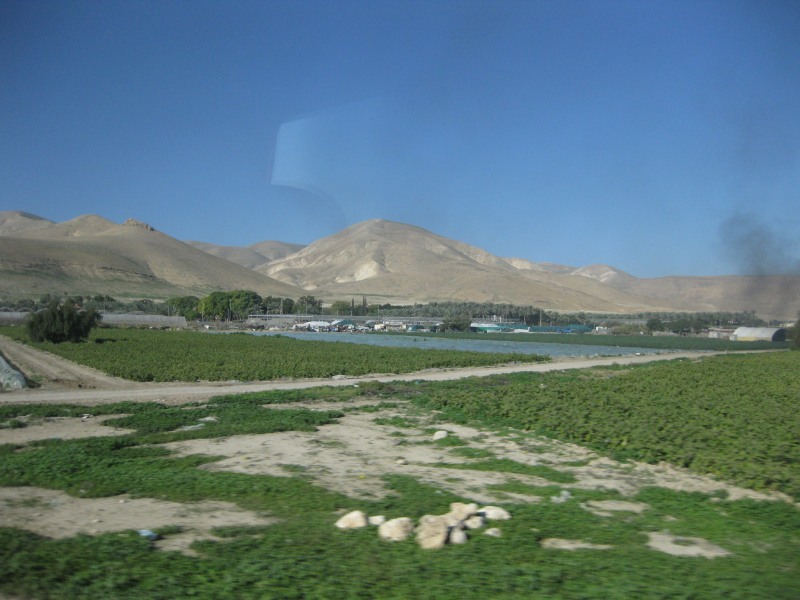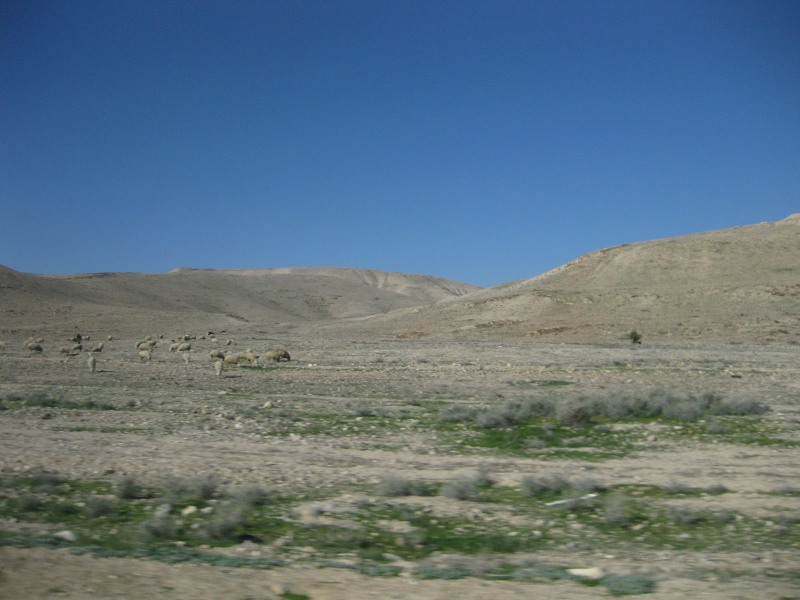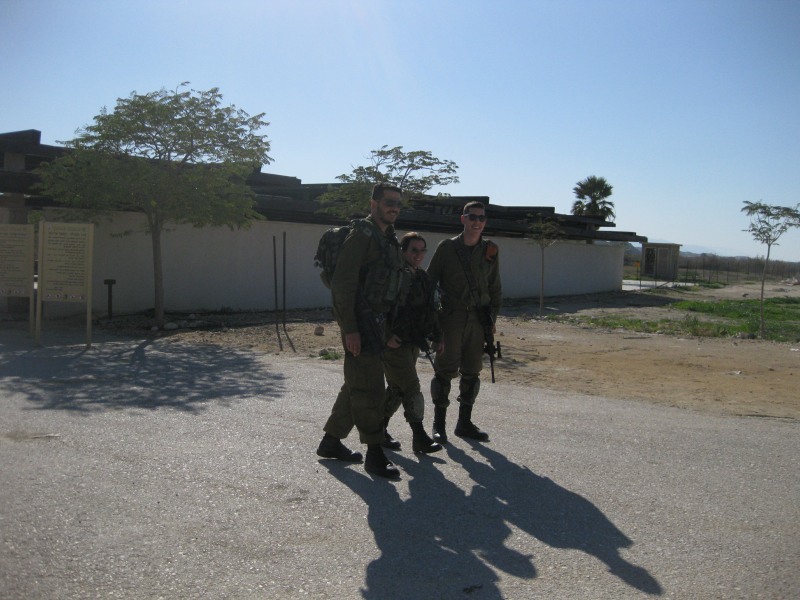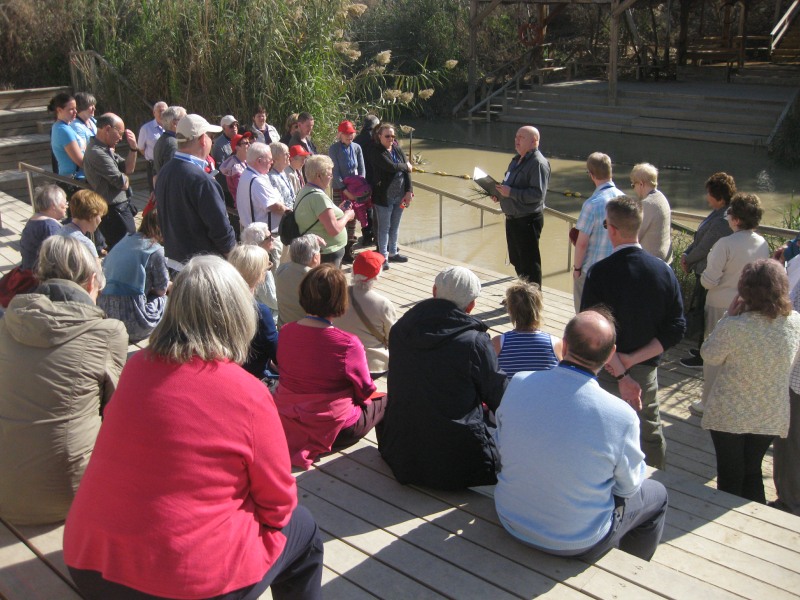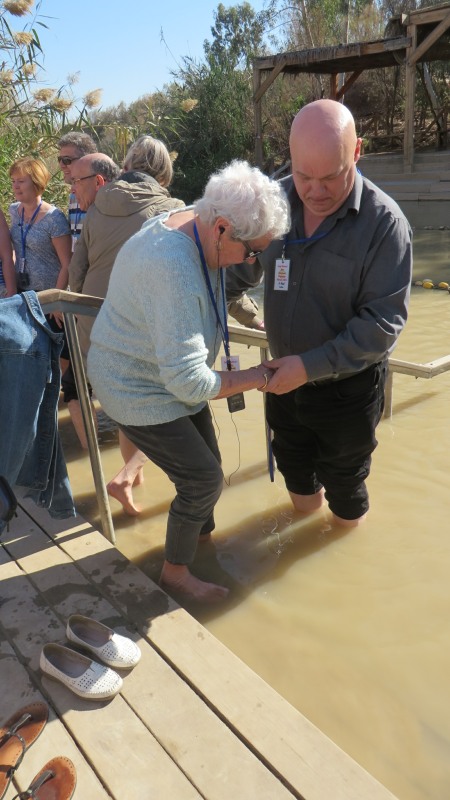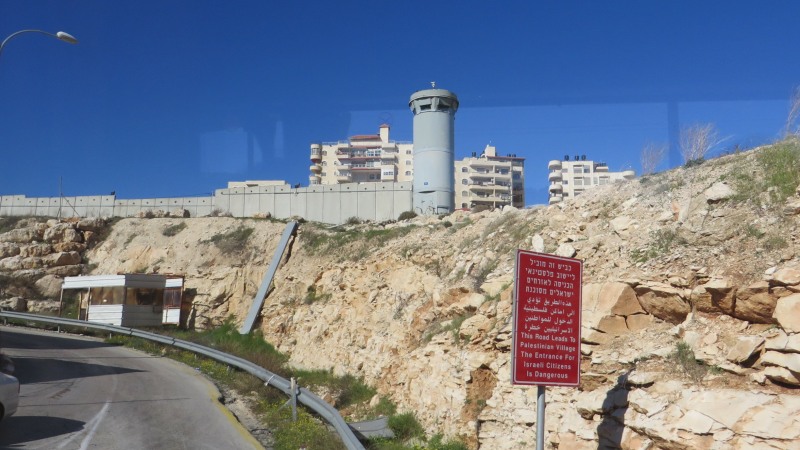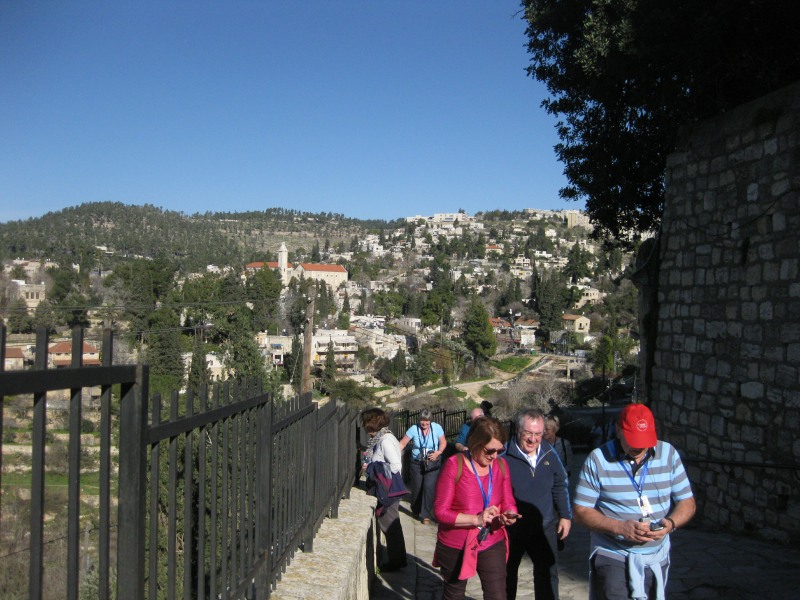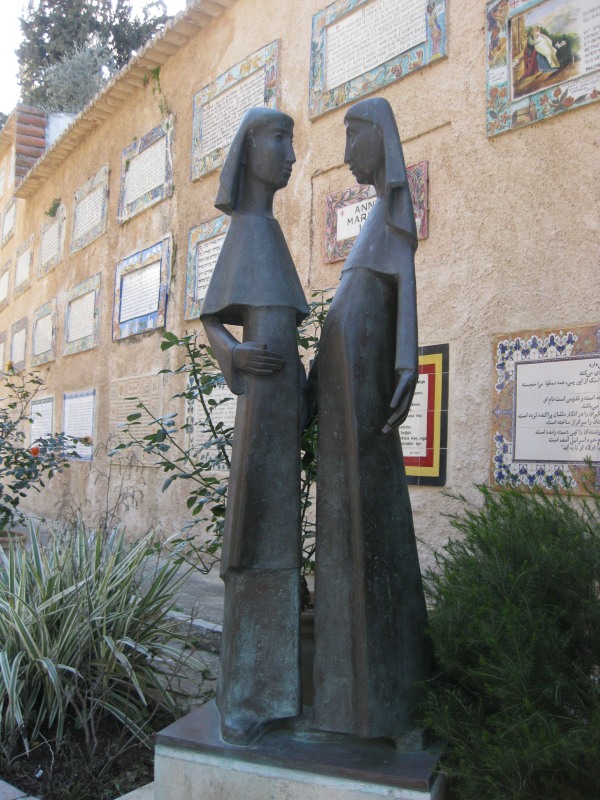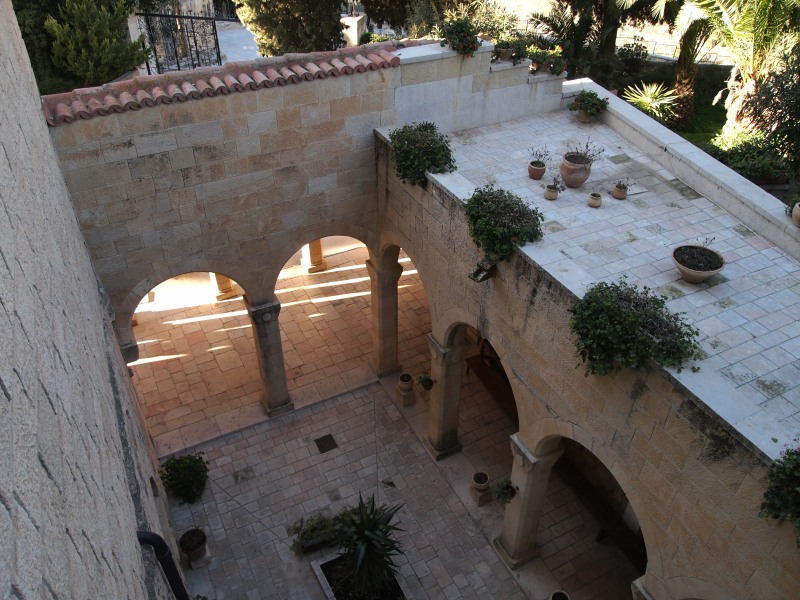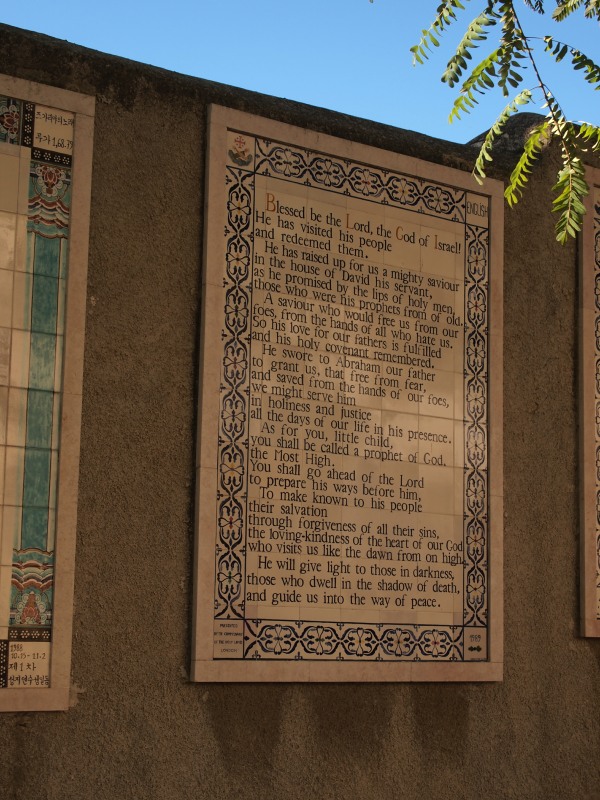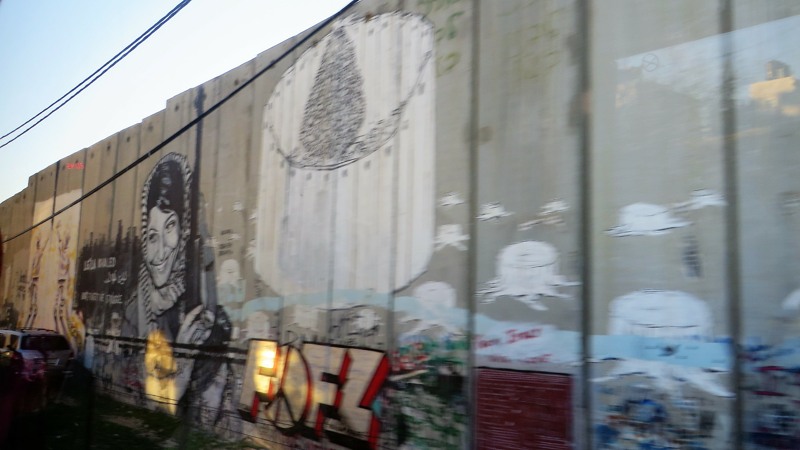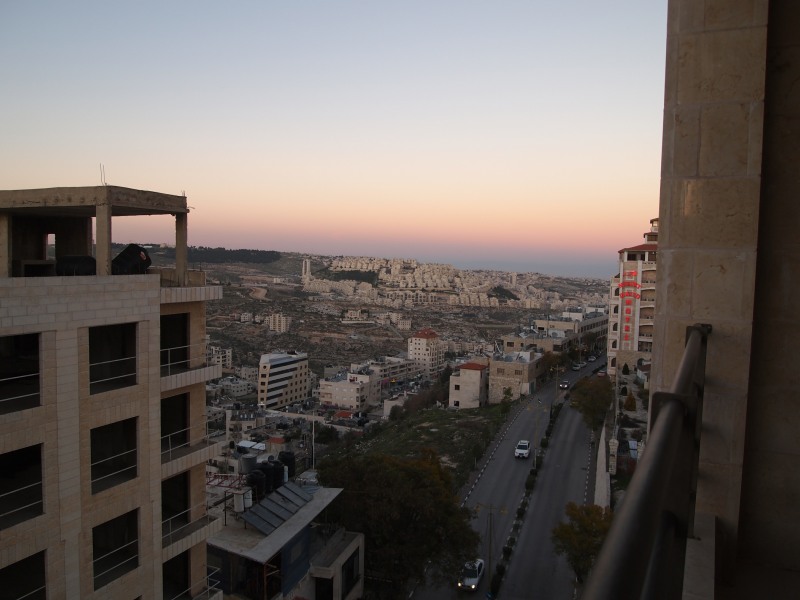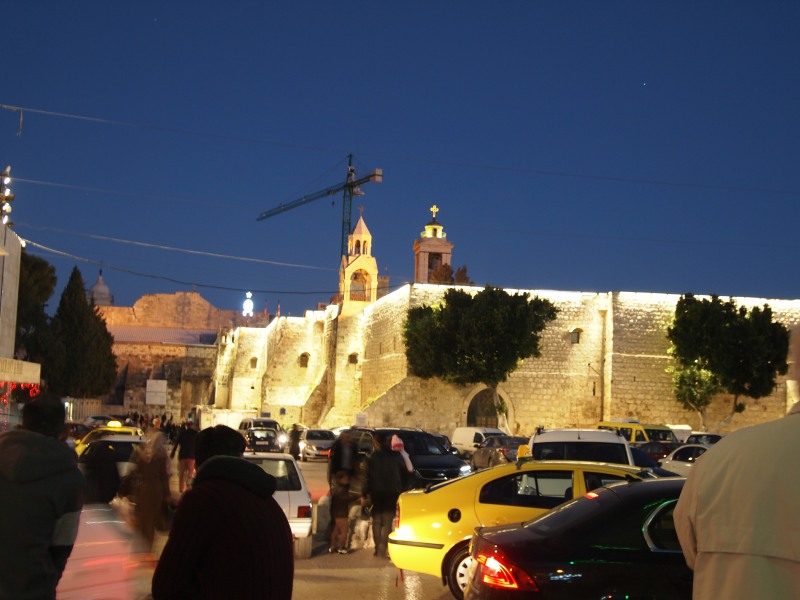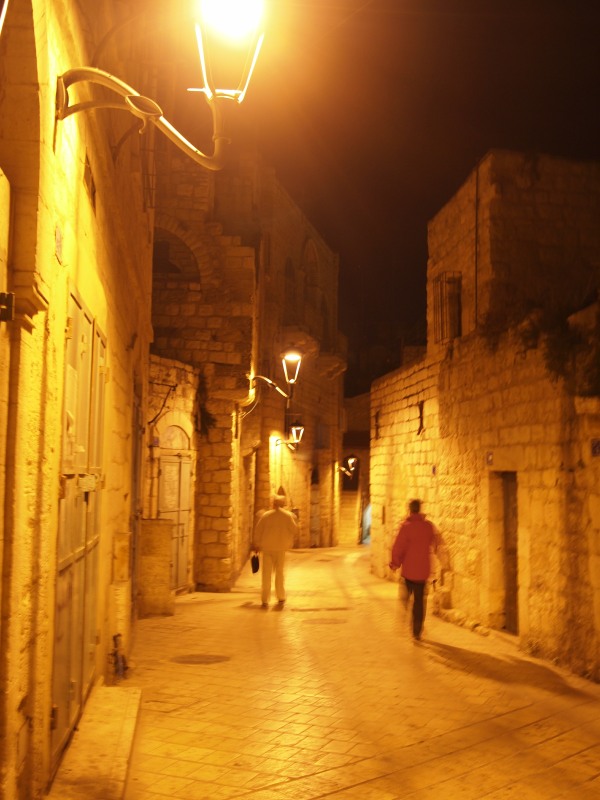I awake early, unable to sleep, my mind a hive of activity trying to process my impressions so far. I get out of bed to look out of the window. A crescent moon hangs in the sky; a bright star - maybe a satellite - can still be seen. The sky is changing from the dark of night to pre-dawn light, reddening above the hills on the far shore. It is windy. I open the window and my hair is ruffled by the strengthening breeze. The lake is no longer smooth; wavelets lap its shores with a gentle susurration, just audible in the still of the night. I breathe deeply and then, feeling the chill in the air, go back to bed. Later, after breakfast and the identification of our bags for loading, we board the coach, ready for the next part of our journey.
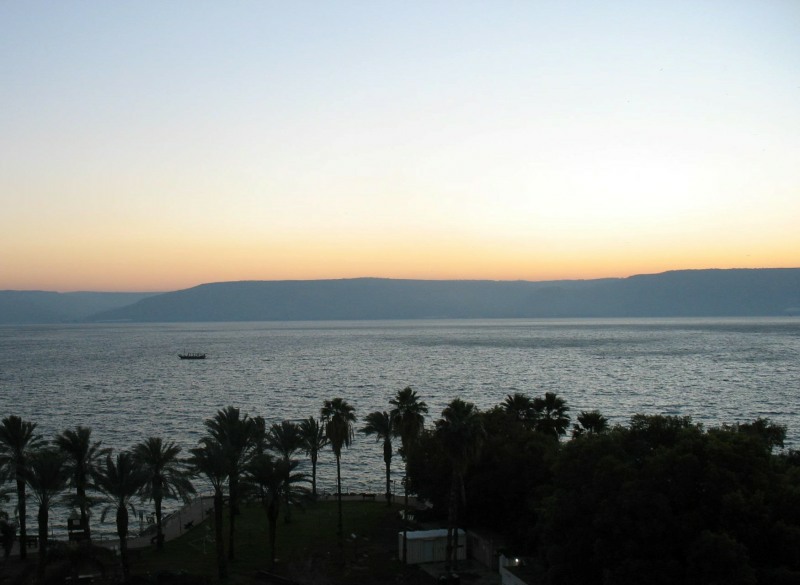
The road through Tiberias follows the shoreline of the lake. I think to myself how similar it is to other tourist destinations with its hotels and restaurants lining the route, and yet how very different too. As we reach the outskirts of the town we cross the outflow from the Sea of Galilee, the River Jordan. The site used to commemorate the Baptism of Jesus for many years is pointed out to us. Now, the place of the Baptism has been re-located further south, to coincide with the traditional location on the Jordan side of the river. Pilgrims had voted with their feet and travelled to Jordan to visit the original site, so it was deemed to be financially expedient to relocate to the same area.
As we turn southwards the landscape starts to change. In the northern part of the Galilee the land seemed to be rich and fertile - green fields were criss-crossed with tracks. Within the fields grew small groves of olive or orange trees, farms of banana plants or date palms, with plenty of herbs and other unidentified shrubs around. Here the land is more intensely farmed and food production is on a much larger scale with vast areas devoted to one specific crop. Date palms are particularly in evidence and olive trees are more rigorously maintained, standing in row upon row in the stony ground. There is even a pig farm, decking placed on the ground upon which the pigs are kept so that their trotters don't touch the ground and become unclean......... The side of the road is littered with rubbish, remnants of farming activities and the plastic sheeting used to protect crops in their own miniature green house. A layer of low lying mist marks the line of the river to our left.
Usama distributes maps to us all and then, using a similar map of his own, gives us a potted geography lesson. The map denotes the Holy Land and the main routes. Today's modern roads follow the ancient trading routes from Egypt to Syria and beyond. These routes would have been very familiar to Jesus and his followers as they journeyed around the land and to Jerusalem. Today, we are following that same main route down the Jordan Rift Valley to Jerusalem, albeit modernised over time and no doubt with some slight variations to the original. The landscape is gradually changing again, relatively green, arable vegetation with stones cropping through gives way to dry, arid desert. Layers of land folded with time curve around us, marking past geological upheavals and changes in the flow of water as it filled the wadis, the layers differing slightly in colour show variations in the climate of each period of time. It is evident that this would have been a difficult journey for any one travelling over 100 miles, by foot, 2000 years ago. Usama talks again about the authority of Jesus and the affect he must have had on his disciples to inspire them to leave their homes in the relative safety of Galilee to follow him on his journey to Jerusalem. It must have been a terrifying leap into the unknown for each of them but shows the complete faith and trust they had in the Lord. I think of my own faith, would I have had the courage to follow Jesus as his disciples did? More importantly, do I have the courage now??
Jordan Valley Landscapes Gallery
Gazing out of the coach window, I see the lines of crops in the fields have been replaced by lines of barbed wire fences demarcating the border, gradually coming nearer and more defined until they enclose the road on either side. A large gun emplacement on the hills above threatens menacingly across the border........And yet the threat is challenged by the presence of the occasional flock of sheep, each with its own shepherd, scrambling among the rocks, seeking a mouthful of grass or feeding from the branches of low lying bushes. Each shepherd is attentive to his flock as he walks beneath the hills or along the roadside, careful to keep the sheep safe from harm and passing vehicles. At times we pass a small grove of trees where the flock and their shepherd have stopped to rest in some small shelter from the sun. I have a sudden insight into Jesus's parable of the Good Shepherd. The nomadic life of the Bedouin and his flock is as valid today as it was 2000 years ago. Each shepherd is still as caring for his flock now as then.
We turn off the main route to pass between fields of stone bordered with high fences, warning signs for mines helpfully attached to them - a little un-nerving, but Usama declares that he knows where the mines are....... We pass through a security check and then into a newly built area for visitors. We have reached the site on the Jordan of Jesus's Baptism by John the Baptist. We step off the cool air-conditioned coach into the heat of the sun.
We immediately see three conscripts to the Israeli Army enjoying some free time, or perhaps checking out their Jordanian neighbours on the other side of the river. They stop and pose for us as we take their picture, seeming to be slightly amused by our actions. We make our way down to the river, passing the newly constructed Visitor Centre and carefully planted palm trees. As we approach the river we can see several buildings on the opposite bank - these are all churches erected by various Christian denominations in celebration of this sacred place. On our side, further back towards the road, there is one dilapidated ruin of a church, somehow still standing.
Descending some steps we come to the Baptismal area. Newly constructed boardwalks and handrails lead into the water and floats mark the extent to which visitors may go. The river is relatively narrow, but bearing in mind the climate, this is not entirely surprising. Its murky waters flow silently by. The banks are festooned with waving grasses, pampas and scrubby bushes. It is very peaceful. As we gather around, Fr Paul (the elder) reads from the baptismal rite and we renew our baptismal promises, which we follow with an Our Father. We've frequently renewed our promises at various masses over the years, but rarely in a place of such significance. It makes me really think about what I am saying, what I am committing to..............
Needless to say, several of us take off our shoes and socks and venture in to the water, cool and refreshing in the heat of the day. The silt and mud squelch between my toes. I feel like a child at the seaside! Clambering out, we sit on the stepped seats and wave our feet in the warm air to dry. The atmosphere is festive and humorous and I have a conversation with Brenda wondering if the same atmosphere prevailed at the time of Jesus. We decide it probably was. I suppose the significance of what was seen, heard and done at the Baptism of Jesus only became apparent after the event. For others gathering to be baptised by John, perhaps it was a bit of a family day trip to see this guy and listen to what he had to say.
We continue on our journey, the next destination being Jericho, but first we skirt the main town, passing a sycamore tree linked to the story of Zacchaeus, and make a stop for a view of the Mountain of Temptations. This inhospitable hill looms high above us. Perched on its precipitous sides is a monastery, which has been there for many years, and a restaurant, which is relatively recent. The reality of the modern world crashes in to my thoughts as I spot a cable car overhead - useful for anyone who wants to visit these places. We pose with the camel or pick up various souvenirs or items of food and drink from local people, pleased to see us and desperate for our custom, before returning to Jericho proper for mass.

Mountain of Temptations Gallery
Archaeological finds in Jericho date the town back between 8000 and 9000 years. Just 1% of the population of the town is Christian, numbering between 350 and 400 people out of a total population of around 4000. Behind high walls lies the Church of the Good Shepherd, cared for and owned by the Franciscans. Next door to the church is a large school, again run by the Franciscans. The size of the school seems disproportionate to the size of the Christian population, but it emerges that it is also attended by Muslims, who make up over 90% of its roll. This small Christian community receives no funding from the Palestinian Authorities and relies entirely on the good will of the pilgrims who visit to fund and maintain its buildings and school. The spiritual support provided by such groups goes a long way in bolstering their faith and commitment to the work they do, by letting them know that someone out there cares for their plight and they are not forgotten.
We enter the church with its whitewashed walls and marble floors, simply decorated. Stained glass windows telling the story of the Good Shepherd, the healing of Bartimaeus and the story of Zacchaeus surround a large painting of the Good Shepherd. It is here that we celebrate mass. During mass we sing 'The Lord's My Shepherd'. The context of the church, the flocks we passed en route, the difficulties facing these people all merge together as one. I pray that the Lord takes particular care of this beleaguered community.
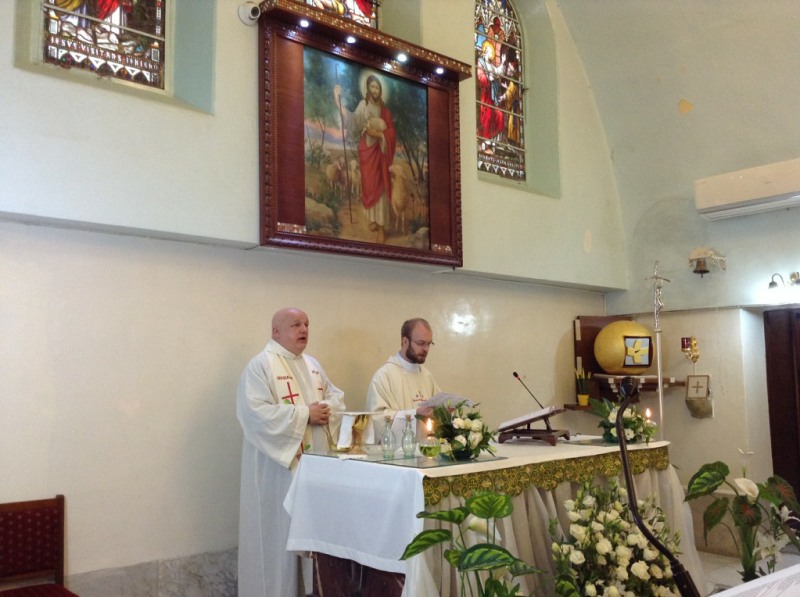
During mass the cry of the muezzin rings out from a nearby mosque. I am irritated at first, but then think does it really matter? Tolerance for others is what we are taught in the Gospels, who am I to criticise or judge how others practise their beliefs? We leave the compound to go back to the coach and are met by a young boy selling oranges. He looks terrified. Several of us pay $1 and receive our oranges in return, encouraged by one of the party who takes pity on the lad and does his selling for him. As we set off on the bus, I notice graffiti on the exterior wall of the church. Although the Franciscan community does so much for the town, there are fundamentalists who still encourage hate and fear.
Church of the Good Shepherd, Jericho Gallery

We stop for lunch at an indoor shopping area lying next door to Tel es-Sultan - the site of the digs taking place in the city. Jericho is the oldest inhabited town in the world. It also lies more than 800 feet below sea level and grew from an oasis area in the desert. The day is hot and our lunch break gives us a chance to soak up some sun.
Our route towards Jerusalem involves climbing steadily uphill through the desert scrubland, out of the low lying valley of the Jordan. In the distant haze we see the Dead Sea. The road seems relatively new. Occasional Bedouin camps can be seen to right and left, permanent structures now, but with a nod to their traditional nomadic life style.
We also see evidence of Israeli settlements - large swathes of land walled off and inhabited by settlers who feel it is their birth-right to live there, regardless of the impact it is having on the local Palestinians. The latter can find their village cut off from their traditional farmland, even families separated by a wall of concrete. They are slowly, inexorably being squeezed off and out of their land.
A road sign warns Israeli citizens that they are entering a Palestinian village and that it is dangerous to do so. Above the road, a watch tower monitors our passage and those who are passing. A high wall of concrete lines the bank of the road. We reach a check point - and are waved through after a brief word from Usama. Beyond we can see evidence of further construction work. Eventually to our left we see the golden dome that marks the roof of the Dome of the Rock gleaming in the sunshine - Jerusalem, the Holy City.
For now, we by-pass the centre of the city and travel to the west side, to Ein Karem, the traditional location of the home of Elizabeth and Zechariah, the parents of John the Baptist, and the place of John's birth. Our road winds down into a tree lined valley and the coach stops to let some of us out. Ahead of us a steep, stepped, marble flagged path climbs up the hillside. As we climb, the view opens out to further reveal the extent of the rich, luxuriant valley.
In front of us lies the Church of the Visitation built on the site where it is believed that Mary visited her cousin, Elizabeth, who greeted her with the words 'Blessed art thou among women.' The walls of the churchyard are covered with the words of the Magnificat - 'My soul glorifies the Lord...' the hymn of praise sung by Mary - in a variety of languages. I spot the Latin version and I'm immediately taken back to my school days when this was sung on a regular basis at all important events. As a group we say together this great song of praise and, thereafter, I find the tune running through my head, mentally singing the prayer again in thanksgiving.
There is a beautiful sculpture of the Mary and Elizabeth, which captures the essence of how two expectant mothers-to-be might meet each other. On the outside wall of the church there is a mosaic of Mary travelling to meet her cousin, the village of Nazareth and Ein Karem with Elizabeth waiting to greet her are in the background.
We explore further. The lower part of the church reveals an ancient cistern or well, believed to have been the water source for Elizabeth and Zechariah. There is also a rock behind which it is believed that John was hidden as a baby when Herod ordered his soldiers to kill all male children under the age of 2 years.
The upper church was designed by Antonio Barluzzi, who also designed the Church of the Beatitudes. The walls are covered with murals depicting the titles which are given to Mary by Christians and stories of the life of Jesus. We look to see if we can spot the image of Barluzzi himself which is included in one of the pictures!
Usama tells us that scholars have discussed why the home of Elizabeth and Zechariah is in one place and yet the birth of John traditionally took place in the location of the church we can see in the village below us. A mundane thought occurs to me that a woman heavy with child would not want to be walking up and down this hillside every day...!
Church of the Visitation Gallery
All too soon we must take our leave and descend the path to the road and on to the centre of the village to the Church of St John the Baptist. In the courtyard outside the church we are greeted by those in our party who did not make the earlier climb. We pause to say together the Benedictus which is portrayed in many languages across the wall.... 'Blessed be the Lord, the God of Israel. He has visited his people and redeemed them...'
The Franciscans are the custodians for this site, which has remains and artefacts dating back to the 1st century and includes structures from the Roman, Byzantine and Crusader periods. Within the church lies the entrance to an area which was originally part of a cave. It is within this cave that tradition places the birth of John the Baptist.
Church of St John the Baptist Gallery
We make our way back to the coach for the last part of our journey to Bethlehem.
There is a build up of traffic as we approach the border crossing. Wire fencing becomes more evident. Tall, white-washed concrete slabs mark the division between Israeli territory and Palestinian territory. Unseen watchers in towers peer down on the passing travellers. Cars are pulled over, their drivers questioned by soldiers. The feeling is oppressive.
We are warned that soldiers may get on the bus to check us out, but not to be worried if they do. We crawl to a halt at the checkpoint and Usama gets off the coach to speak to the border patrol - young soldiers, heavily armed. He is allowed back on to the bus and we are waved on through.
I watch the wall turn from a clean, freshly whitewashed surface to a grey, graffiti covered protestation by the Palestinians of their treatment by the Israeli Authorities. The overriding theme is a cry for freedom, of escape from this place. Bethlehem is just 5 miles from Jerusalem, yet it could be 500 miles when I look at the difference in the faces of the people, in the fabric of the buildings..... We pass a side street and I spot a shop, 'Banksy's Shop'. It emerges that Banksy himself has created some of the images on the wall in support of the Palestinians.
We soon arrive at our hotel and receive a wonderfully friendly welcome from the manager and his staff who are not only delighted to see us, but are also thankful that we have chosen their hotel rather than another in the town - their lives depend on such support from beyond the wall. In gratitude no task is too much for them and we are treated like VIPs, their faces constantly wreathed with smiles.
Three of us have arranged to meet up as soon as our bags have arrived in our rooms for a quick trip into town. I don't bother to unpack but, after taking a quick photo of the view, rapidly exit my room, back to the lift, to find myself arriving on the wrong floor - so much for hurrying! A helpful hotel worker sends me back up to the lobby and the three of us leave the hotel.
What follows is a whirlwind tour.
It is dark now and street lights cast their neon light over the narrow roads. We hurry along up a gradual slope, passing the long wall of the Salesian Convent and the Nativity museum. Turning left down some wide steps, we come to several shops, still open. From the shadows a voice calls 'Welcome! Thank you for coming!' On one corner the irresistible smell of freshly baked bread wafts over us and we stop to buy some pitta bread - round and warm, sprinkled with herbs, meltingly delicious. Further on a shop selling freshly cooked falafel entices us - the best I have tasted yet! Our route continues past further stalls, each owner keen to attract our custom.
Eventually we find ourselves in Manger Square, a large square in front of the Church of the Nativity, currently filled with parked cars. We cross over the square and come to a smaller, quieter area, immediately in front of the church. In front of us, a low doorway marks the entrance. We pass through - into an area where there is a great deal of renovation taking place. Scaffolding surrounds pillars and reaches up into the roof of the church. We quickly walk on, winding our way through the metal-work and sheet-covered areas to a side altar in an apse. In the corner there is a steep, curved, set of steps leading down to a small entrance and then between narrowed walls and more steps into a small chamber.
It is peaceful, the air is still and warm. Drifting from a multitude of burners, the sweet smell of incense fills the space. The lower wall to one side is veiled with a cloth of gold. An opening at the bottom reveals a marble flagged area, lined with images and hung with more incense burners. In the base of this area is an small cavity outlined with the shape of a silver star. This is the location that Jesus, our Saviour, was born 2000 years ago. Kneeling down, I reach in and place my fingers into the opening.
2000 years ago shepherds had hurried through the dark night in the town of Bethlehem, eager to pay homage to the child angels had told them about. And now, having mirrored that rush through the streets of Bethlehem, I am kneeling in that same location - I give thanks to the Lord for sending us His Son.......
To my right is a second opening cut into the rock. It would have been in this cave where the animals would have been stabled. We stand in silent prayer for some minutes, enjoying the quiet of the moment, in the company of a handful of fellow believers.
Moving on, we pass through a dark cloistered area to the Church of St Catherine. The custodian of the church comes to let us know that he is about to lock up but gives us a few minutes to descend a steep flight of steps to visit the chapels of St Jerome and of St Joseph. It is here that we will have our mass tomorrow.
We emerge back in to the night of the town. It is perceptibly cooler now, as we dash back through the streets to our hotel, ready for dinner after this long, busy, day.
~~~~~~~~~~~~~~~~~
Day 3 - For Nothing is Impossible to God
The thoughts and impressions stated are those of the writer only and may not reflect the feelings and opinions of others in the group.

